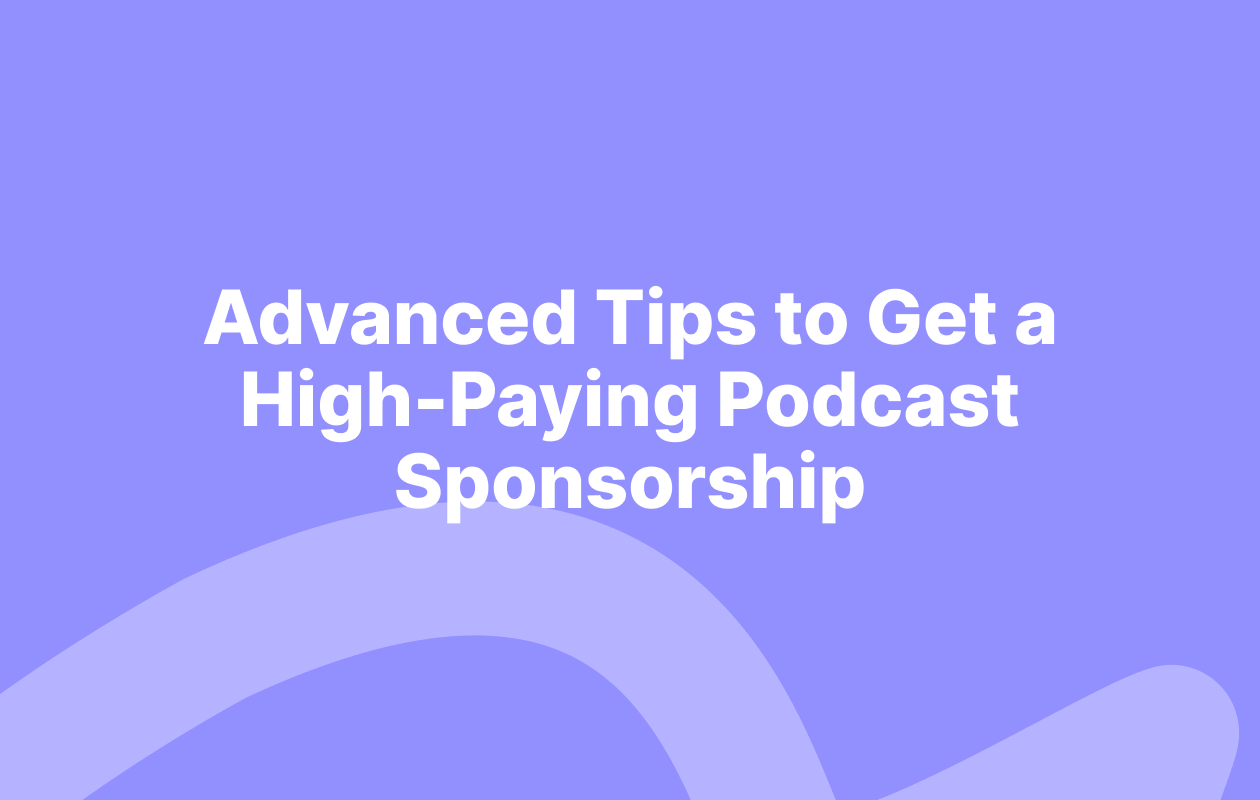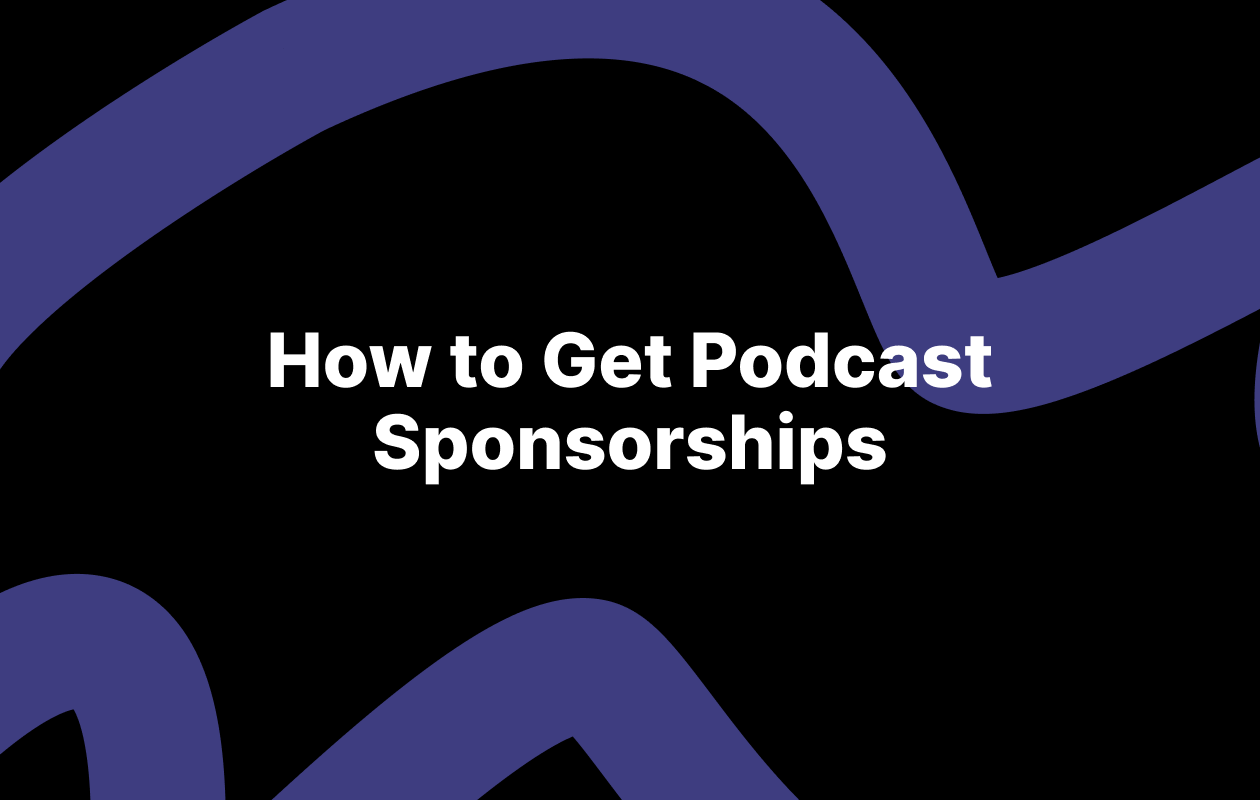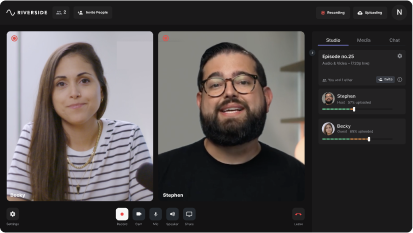Last Updated
May 26, 2023
Advanced Tips to Get a High-Paying Podcast Sponsorship

You’re probably not podcasting just for the money—but it doesn’t hurt, right?
And if you’ve been around awhile, you know that there’s a difference between landing that first sponsorship deal and finding those golden ticket sponsors who are not only a perfect fit for your niche and audience, but are willing and able to pay what you’re worth.
In our previous post, we shared an introduction to how to land sponsors for your podcast. But if you’re hungry for more details and advanced tips for finding those high-paying podcast sponsors who can get you where you want to go, you’re in the right place!
Podcast Sponsorship Overview
Before we dive into the advanced tips for landing high-paying sponsorship deals, let’s make sure we have the basics down.
Monetizing a podcast generally works in one of two ways: direct monetization and sponsorship. While direct monetization methods like using a Patreon subscription model or setting up a GoFundMe can work for some podcast creators, most podcasters look to traditional sponsorship as a reliable source of revenue.
With traditional sponsorship, brands pay you to promote their product or service on your show. These sponsored ads are inserted into the beginning (“pre-roll”), middle (“mid-roll”), or end (“post-roll”) of an episode, and most brands pay a rate based on the number of downloads per episode your show receives.
This method is called cost per mille (CPM), or cost per thousand downloads. The industry-standard rate for the CPM model is between $18-25 per thousand episode downloads.
Other sponsorship models include affiliate sponsorship, where creators are paid a commission on the sales they make for the brand, and value-based sponsorship, where the creator negotiates a flat sponsorship fee per show rather than pricing based on the number of downloads.
The Basics: How to Find a Podcast Sponsor
Podcast creators typically find sponsors in one of three ways:
- Joining a podcast network—Third-party networks, like Midroll, AdvertiseCast, and PodcastOne, connect podcasters to brands. This method is easiest, though you’ll have to sacrifice a cut of your earnings (an average of 30%) to the network’s fees.
- Pitching directly to sponsors—This extremely common method involves researching brands that might be interested in collaborating, then sending a proposal demonstrating how beneficial a partnership could be for them. Then, if they agree, you work out a sponsorship contract between the two of you.
- Being approached by a brand—This method is the most desirable. Once your podcast is big enough, brands will approach you asking if you’d be interested in being sponsored by them.
Some podcasters start looking for sponsorship after reaching 500 subscribers, while others wait until they’re in the thousands range. The point at which you’re established enough to seek out sponsors is a different benchmark for everyone.
If you want a deeper dive into the fundamentals of podcast sponsorship, be sure to check out our post: How to Get Sponsorships for Your Podcast.
6 Advanced Tips to Get a High-Paying Podcast Sponsorship
Knowing how podcast sponsorship works may not always be enough to get the most out of the deal. Let’s look at six advanced tips to keep in mind if your goal is not just to find a sponsor—but to land a high-paying sponsorship.
1. Choose Sponsors Wisely
The first piece of advice we can give you is to be discerning with the sponsors you agree to partner with.
At this point, turning down any sponsors may feel like a luxury you can’t afford. But consider how partnering with the wrong brand might do you more harm than good in the long run.
For instance: have you ever listened to a podcast on fitness and nutrition, only to hear a jarring advertisement for a fast-food delivery service in the middle of the episode?
You’d be thrown off—not to mention lose a bit of trust in the podcast host—right?
That’s why you should only partner with brands that add relevant value to your listeners. Make sure the brand you agree to work with fits with your podcast’s topic and audience’s interests.
Here’s a helpful framework for choosing your next sponsor:
- Consider your ideal listener. Create an audience persona—a hypothetical person based on your real audience. What are their interests? What demographics (age, gender, income level, etc.) do they fit into? If you have a wide range of listeners, it’s okay to create two or three audience personas.
- Does the brand fit your ideal listener’s needs/wants? Once you have an idea of your audience persona, you’ll be able to consider whether the products or services sold by a potential brand partner would be of interest to your target audience. If they don’t, that sponsor may not be a good fit.
- Does the brand fit your podcast niche? Make sure to consider the values, topics covered, and goals of your podcast. The product or service you’re promoting shouldn’t go against the values or ideas promoted in your podcast.
And whatever else you do, choose companies that you respect and feel good about promoting. Remember: if you feel sleazy when recording that ad copy, you’ll probably sound sleazy.
2. Cold Pitch
Next, if you’re serious about earning a high income from podcast sponsorships, steer clear of podcast networks. They may be helpful for newbies who don’t have many connections or a large audience—but if you want to maximize your income, reach out and pitch your dream sponsors on your own.
That way, you can negotiate the rates and payment structure from scratch. You also won’t have to worry about sacrificing 30% of the revenue to network fees.
To cold pitch successfully, start by making a list of brands that you think would benefit from advertising to your audience. Using your audience persona, find brands whose products would answer your audience’s pain points or provide real value to them.
Then, create a sponsorship proposal and send it to the person at each company who’s likely to have the power to make marketing and advertising decisions. Use hard data in your proposal, such as demographic analytics and download metrics, to help convince them of the ROI they can expect when partnering with you.
3. Lean into Your Niche
You can charge more to run ads if your podcast is more specialized. If you want to be able to charge higher prices, consider niching your podcast down.
For example, a podcast about organic gardening can charge higher prices than a generic lifestyle podcast. This is because your core audience is extremely well-defined—meaning that if a brand chooses to partner with you, they’ll have a better idea of how your audience will respond to their product.
If you can show hard data on the exact type of listeners tune in to your show, you’ll be able to find a good sponsorship fit for your audience. Your sponsor can expect a higher return on their investment, and will therefore be more willing to pay higher advertising prices.
4. Create Quality Content to Increase Downloads
Since the most common sponsorship model is based on CPM (cost per mille, or per thousand downloads), it stands to reason that one great way to increase your podcast revenue is to increase your subscriber count.
And the most straightforward way to gain followers is to focus on creating a high-quality show. If you’re not already doing these things, think about starting as soon as possible:
Use Podcast Episode Scripts
By creating a solid structure for each episode, you’ll have fewer mistakes and a tighter end result for your audience.
Also, using a script template for each episode will help you make a habit of including important calls to action, like reminders to subscribe to and review the podcast.
When writing your scripts, you can also make sure to work in the right number of keywords for search engine optimization (SEO) to help your podcast rank on the first page of search results.
Conduct Interviews with High-Profile Guests
If conducting interviews fits with the style and format of your show, try to invite as many high-profile guests as possible. Don’t let imposter syndrome hold you back; you’d be surprised how little clout you need to get high-profile guests in your niche to appear on your podcast.
After all, many subject matter experts or celebrities are looking for ways to promote their own books, creative projects, or shows. They may be open to appearing on your podcast in exchange for more publicity for their own endeavors. And in exchange, you’ll get more exposure to their large audiences.
Invest in Professional Recording Equipment and Software
As they say, you have to spend money to make money. If you can, invest in a high-quality microphone, camera, mixer, and studio setup as soon as possible to get the best sound quality.
And don’t skimp on the recording and editing software you use, either. Professional recording software (such as Riverside) leads to a better product that’s easier to listen to. Whatever product you choose, make sure to opt for software that records audio (and video, if possible) locally to each participant’s computer. This double-ender recording keeps you from being reliant on a fast internet connection.
Also, look for software that doesn’t compress the audio and video files like many free video conferencing software options do—while this feature is helpful for fast data transfer, it’s terrible if you want professional-quality recordings.
5. Stay Below 5% of Ads Time Per Episode Length
No audience wants to listen to a podcast episode that’s flooded with ads. One of the biggest mistakes new podcasters can make is to get over-eager with their first sponsorship deals and pack their episodes with promotional content.
After all, if your subscriber base shrinks, how long do you think sponsors will be willing to work with you?
Remember that your show’s primary focus should always be providing value to your listeners, so keep your ad time at or below 5 percent of the total runtime. If your episodes turn into long commercials, your listeners will, at best, start to skip through ads—and at worst, unsubscribe altogether.
6. Create More Content
Of course, the 5% you can spend on ads will get roomier if you have more content to work with. The more content you create, the more potential touchpoints you’ll have for sponsorships.
Release More Episodes
If you’re publishing one episode per week, do you have the bandwidth to go up to two episodes weekly? More episodes mean more available space to fill with paying ads.
That doesn’t necessarily mean you need to double your workload, though; you can always throw a few lower-effort episode structures into the mix, such as:
- Q&A or mailbag episodes
- Mini-episodes touching on an inspirational quote or short thought
- Solo episodes (if your regular show features interviews with guests)
- Reruns of old episodes (works especially well if you’ve been on the air for several years)
Just make sure not to ramp up your production schedule too fast if you won’t be able to sustain that rate long-term. It’s better to scale at a sustainable rate than to burn yourself out trying to maximize sponsorship revenue.
Publish Your Content in More Places
The more places your content is available, the more exposure it gets—and the higher the likelihood that your subscriber count will skyrocket.
For example, consider posting clips to social media, live-streaming your show, or creating a video podcast on your YouTube channel.
Choosing a software solution like Riverside will enable you to more easily publish and repurpose your content, since Riverside automatically records video along with your audio. It also offers live streaming to Twitter, YouTube, and Facebook as part of all membership tiers.
Send Show Notes via Email List
Another way to market your podcast and get more eyes on your product is to send regular newsletters to your email list.
Do you already publish show notes on your website? Consider blasting them out to your subscribers’ emails as well. Not only is this a free way to connect with your audience via another channel, but you can include ads built directly into your emails—meaning that’s yet another opportunity for sponsorship revenue.
And if you’re looking for other content for your newsletter, consider teasing upcoming episodes, asking your audience to send questions for your next mailbag episode, or share entertaining, behind-the-scenes footage from your production.
Final Thoughts
For many podcasters, landing sponsors is a sign that you’ve made it. You’re finally being paid to do what you love.
But if you’ve already been around the block a few times, or you have specific revenue goals in mind, it may not be enough just to land any sponsorship deal. If you want to start finding those high-paying sponsorships, make sure to be discerning about who you partner with—and don’t be afraid to cold pitch potential sponsors that you’re confident would be a good fit.
And utilize strategies to optimize your potential return on investment, like leaning into your niche, limiting “commercial time” to 5% of each episode, and improving the quality and quantity of your content.
As always, the best strategy for success is to be confident in your goals, ask for what you want, and keep your focus on creating quality content that delivers value for your audience. When a sponsor sees that, how could they resist partnering with you?
















.png)
.png)
 (1).webp)
.webp)
.webp)








